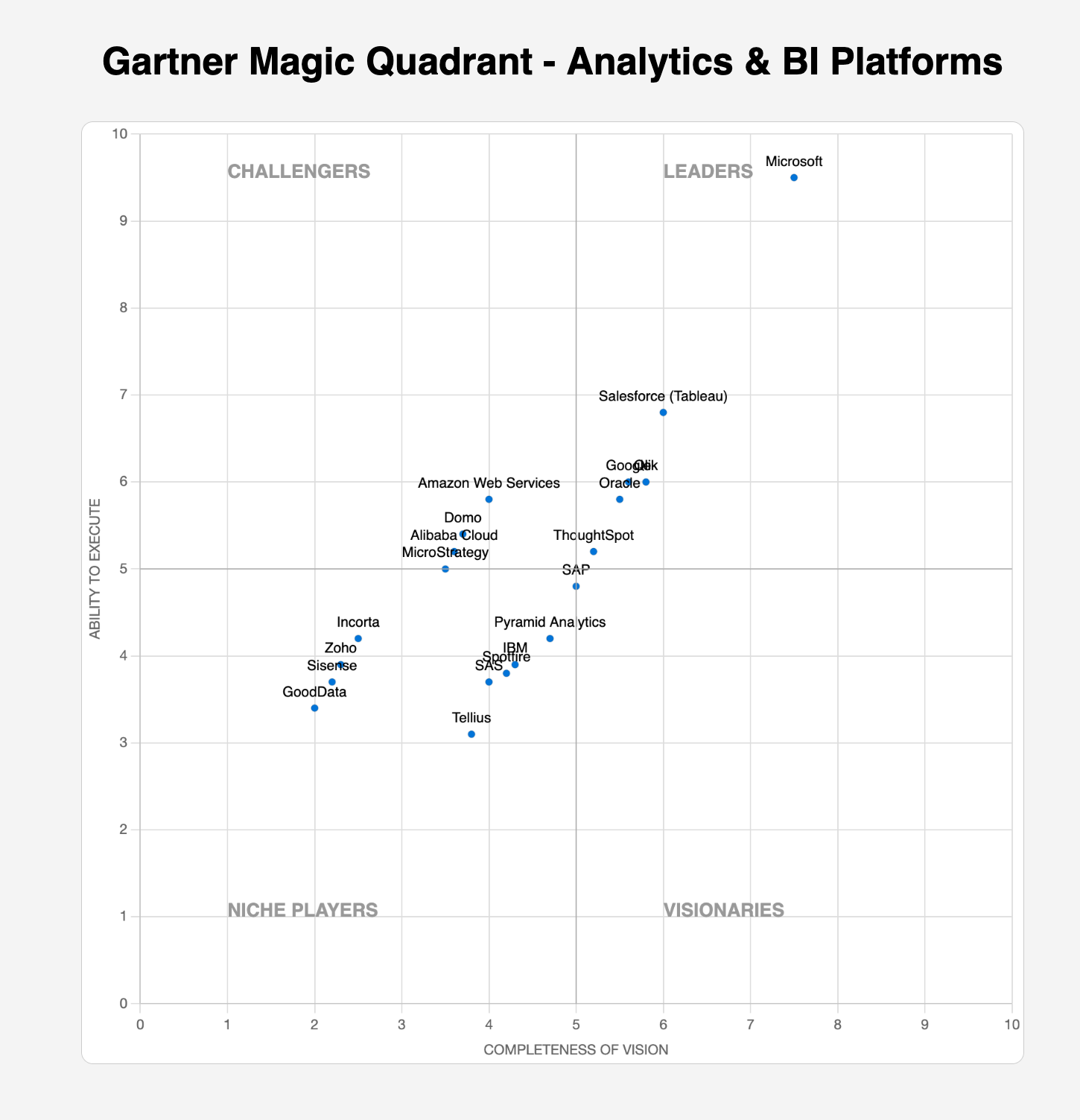Discover which BI and analytics platforms lead the market in Gartner’s 2024 Magic Quadrant. Explore detailed insights, comparisons, and evaluation criteria.

Choosing the Right BI Platform in 2024
Selecting the right business intelligence (BI) platform is increasingly complex. With rapid innovation in AI, cloud integration, and composable analytics, organisations must navigate a growing set of tools and vendors. Gartner’s 2024 Magic Quadrant offers a structured view of the market, helping businesses compare and evaluate solutions based on strategic vision and execution.
This article provides a practical breakdown of the 2024 Magic Quadrant for BI and Analytics platforms, highlighting vendor strengths, trends, and evaluation methodology.
What Defines a Modern BI Platform in 2024?
Analytics and BI platforms today go far beyond static dashboards. They empower users across skill levels to explore, analyse, and collaborate on data with flexibility and control.
Key capabilities of modern BI tools include:
- Data visualisation through dynamic dashboards
- Drag-and-drop data preparation
- Governance and access control
- Integration of machine learning and predictive analytics
- Natural language querying for conversational data access
- Collaboration features for shared reporting and dashboards
Gartner Magic Quadrant Overview: Leaders, Challengers, Visionaries, and Niche Players
Gartner evaluates vendors across two main criteria: Ability to Execute and Completeness of Vision. The resulting quadrant groups companies into four segments.
Leaders
- Microsoft (Power BI): Combines Azure integration, AI-powered features like Copilot, and competitive pricing
- Google (Looker): Semantic modelling, strong alignment with Google Cloud data services
- Salesforce (Tableau): Visual-first design with growing AI capabilities
Challengers
- Amazon (QuickSight): Deep AWS integration; suitable for cloud-native environments
- Domo: Focused on ease of use and marketing analytics for small and medium-sized businesses
Visionaries
- SAP Analytics Cloud: Seamless for existing SAP clients, but limited outside the SAP ecosystem
- SAS Viya: Strong AI functionality, challenged by pricing complexity
Niche Players
- Sisense: Developer-first approach; excels in embedded analytics
- Tellius: Good at natural language and automated insights; less strong in traditional reporting
Market Trends in 2024
Several trends shaped this year’s quadrant and will continue influencing platform adoption:
- Growth of generative AI in analytics interfaces
- Composable analytics frameworks for flexibility
- Support for multicloud and hybrid deployments
- Low-code tools enabling non-technical users to build data solutions
How Gartner Evaluates Vendors
Gartner’s evaluation is based on a weighted scoring model across the two key axes:
Ability to Execute
This measures how effectively a company delivers value to its customers. Criteria include product quality, customer experience, financial viability, and operational performance.
Completeness of Vision
This reflects a company’s innovation, product strategy, marketing, ecosystem growth, and ability to shape industry direction.
Each criterion is assigned a weight and score, then combined using the following formula:
Score = Σ (Weight × Score for each criterion)
The two final scores determine placement on the quadrant grid.
- Top-right: Leaders
- Top-left: Challengers
- Bottom-right: Visionaries
- Bottom-left: Niche Players
Summary of Key Takeaways
- Microsoft Power BI remains the dominant solution in terms of affordability, usability, and cloud ecosystem integration
- Google Looker and Tableau offer innovative features, especially around semantic modelling and augmented analytics
- AWS QuickSight is ideal for organisations already committed to the AWS cloud
- Niche vendors such as Sisense and Tellius bring unique capabilities in embedded and automated analytics, respectively
Final Thoughts
Gartner’s 2024 Magic Quadrant provides a reliable overview of the evolving BI landscape. However, no platform is universally the best. The right choice depends on your business goals, data strategy, user base, and existing infrastructure.
For decision-makers, understanding each vendor’s position in the quadrant—and the reasoning behind it—can accelerate the selection process and reduce risk in BI investment.





















Discussion